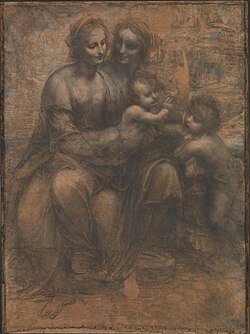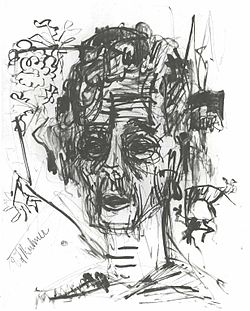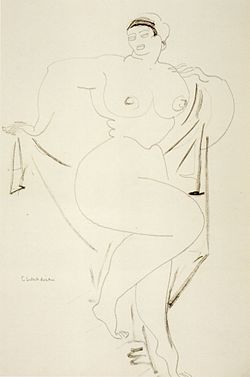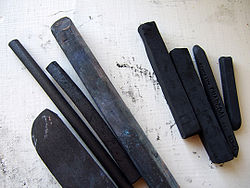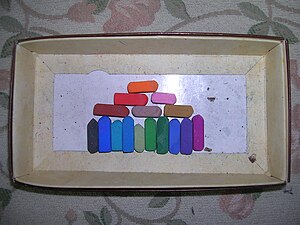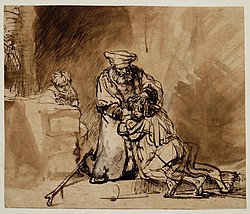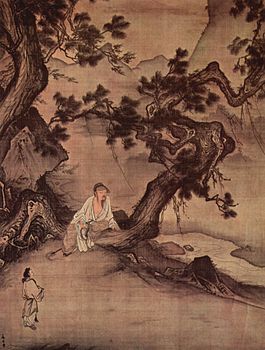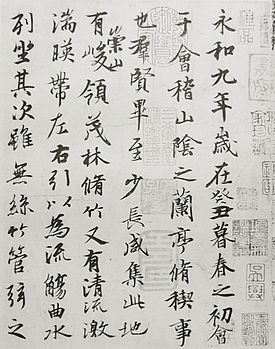Artistic media two dimensional art/ART102/Drawing
Leonardo da Vinci’s The Virgin and Child with Saint Anne and Saint John the Baptist wraps all four figures together in what is essentially an extended family portrait. Da Vinci draws the figures in a spectacularly realistic style, one that emphasizes individual identities and surrounds the figures in a grand, unfinished landscape. He animates the scene with the Christ child pulling himself forward, trying to release himself from Mary’s grasp to get closer to a young John the Baptist on the right, who himself is turning toward the Christ child with a look of curious interest in his younger cousin. In fact, the traditional role of drawing was to make sketches for larger compositions to be manifest as paintings, sculpture or even architecture. Because of its relative immediacy, this function for drawing continues today. A preliminary sketch by the contemporary architect Frank Gehry captures the complex organic forms of the buildings he designs.
Drawing media is organized into two types: dry and wet.
Charcoal drawings range in tones from light gray to rich, velvety blacks. A charcoal drawing by American artist Georgia O’Keeffe shows these tonal ranges.
More recent developments in dry media are oil pastels, pigment mixed with an organic oil binder that deliver a heavier mark and lend themselves to more graphic and vibrant results. The drawings of Beverly Buchanan reflect this. Her work celebrates rural life of the southern United States centered in the forms of old houses and shacks. The buildings stir memories and provide a sense of place, and are usually surrounded by people, flowers and bright landscapes. She also creates sculptures of the shacks, giving them an identity beyond their physical presence.
Felt tip pens are considered a form of wet media. The ink is saturated into felt strips inside the pen then released onto the paper or other support through the tip. The ink quickly dries, leaving a permanent mark. The colored marker drawings of Donnabelle Casis have a flowing, organic character to them. The abstract quality of the subject matter infers body parts and viscera.
Other liquids can be added to drawing media to enhance effects – or create new ones. Artist Jim Dine has splashed soda onto charcoal drawings to make the surface bubble with effervescence. The result is a visual texture unlike anything he could create with charcoal alone, although his work is known for its strong manipulation. Dine’s drawings often use both dry and liquid media. His subject matter includes animals, plants, figures and tools, many times crowded together in dense, darkly romantic images.
Traditional Chinese painting uses water-based inks and pigments. In fact, it is one of the oldest continuous artistic traditions in the world. Painted on supports of paper or silk, the subject matter includes landscapes, animals, figures and calligraphy, an art form that uses letters and script in fluid, lyrical gestures. Two examples of traditional Chinese painting are seen below. On the left, a wall scroll painted by Ma Lin in 1246, demonstrates how adept the artist is in using ink in an expressive form to denote figures, robes and landscape elements, especially the strong, gnarled forms of the pine trees. There is sensitivity and boldness in the work. On the right is the opening detail of a copy of Preface to the Poems Composed at the Orchid Pavilion made before the 13th century. Using ink and brush, the artist makes language into art through the sure, gestural strokes and marks of the characters.
Drawing is a foundation for other two and three-dimensional works of art, even being incorporated with digital media that expands the idea of its formal expression. The art of Matthew Ritchie starts with small abstract drawings. He digitally scans and projects them to large scales, taking up entire walls. Ritchie also uses the scans to produce large, thin three-dimensional templates to create sculptures out of the original drawings.
